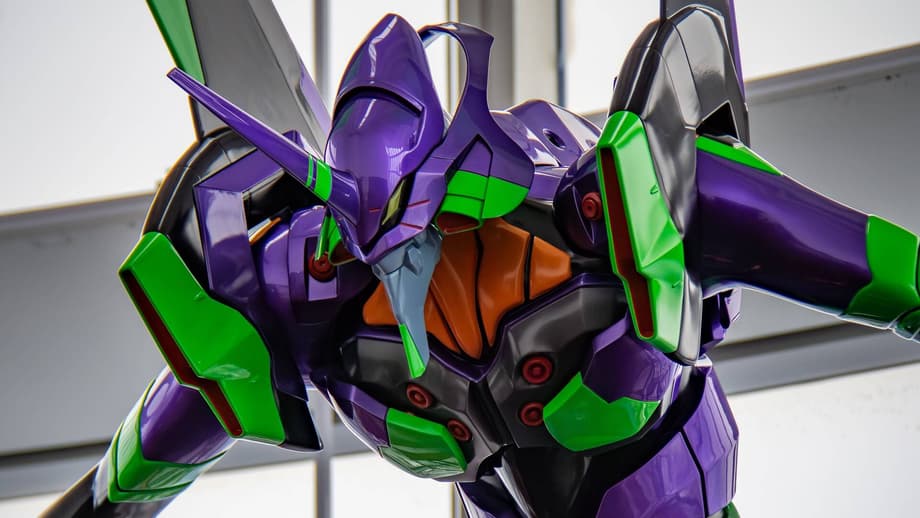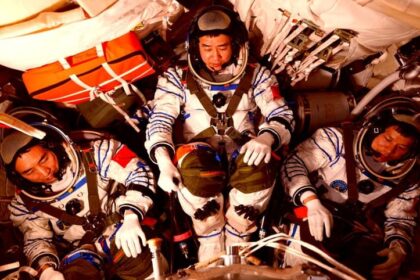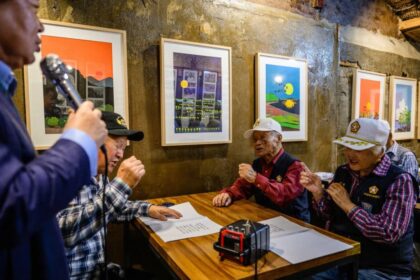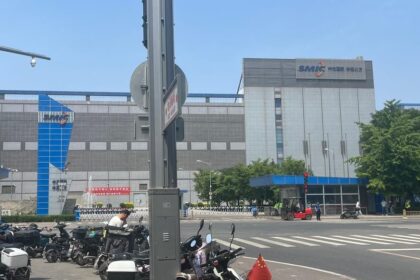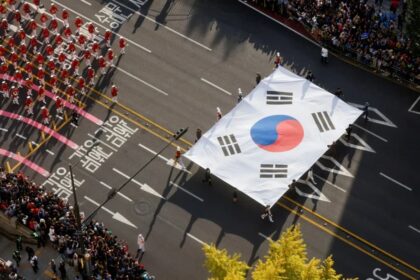A sweeping celebration above Tokyo
Three decades after Neon Genesis Evangelion first aired in 1995, Tokyo is hosting a panoramic tribute to one of anime’s most influential series. The 30th anniversary exhibition All of Evangelion has taken over Tokyo City View, the observatory on the 52nd floor of Roppongi Hills Mori Tower. It runs through January 12, 2026. Visitors step out of the elevators to find a towering Evangelion Unit 01 figure posed against floor to ceiling glass, the Tokyo skyline stretching behind it. The scene feels both theatrical and intimate. It anchors a show that looks back at how Evangelion evolved, and how its creators experimented with tools old and new to expand what animation could do.
The exhibition tracks the franchise from its earliest foundations to its most recent chapter. It opens with setting materials and blueprints that mapped out characters, environments, and the machinery of the story world. Then it moves into the original TV series and the hand painted cels that defined its look. Later galleries follow the transition to digital production for the Rebuild film series launched in 2007, and the hybrid techniques used in the 2021 feature Evangelion 3.0+1.0 Thrice Upon a Time. Storyboards sit next to finished footage. Preview reels sit next to concept art. Visitors can even hear audition recordings from voice actors. The result is a clear line through decades of craft, showing how drawings became scenes, and how scenes became cultural touchstones for fans around the world.
What the exhibition shows
The prologue section focuses on world building. Sketches and notes explain how the series’ creators designed the Evas, the Angels, and the urban spaces that set the tone of the story. Design sheets show how facial expressions, pilot suits, and control rooms were refined. Mechanical charts unpack scale and motion. These behind the scenes documents are paired with display monitors that loop short clips, so visitors can compare the idea on paper and the result on screen. The curators keep the path clear and chronological, which helps newcomers follow the timeline without feeling lost.
A highlight for many is the room devoted to the 1995 TV series. About 270 hand painted cels have been selected from more than 10,000 archived cuts. The display walks through the layers of traditional cel animation. Color keys guide palette choices. Timing sheets mark beats for movement and dialogue. Camera notes show how compositors stacked layers to create parallax and depth. Seeing the brushwork at this scale under crisp lighting makes the manual skill obvious. It also reminds viewers that the original series was built one frame at a time by teams working with pencils, paint, and film cameras.
Another section turns the spotlight to pre production tools. Storyboards map camera angles, timing, and emotion. Preview videos give a sense of pace and music. Audio stations play audition recordings, a rare chance to hear how casting shaped the characters’ voices before any official broadcast. These materials show how directors fine tuned scenes long before animators laid down final lines and colors. For fans who grew up watching the show on television or on home video, it can feel like getting access to the workshop where a favorite piece of pop culture was assembled.
Hideaki Anno, the creator of Evangelion, has often described his process as open to discovery. In a 1996 comment about working on the series, he said the production moved with the energy of a live performance.
The development of Evangelion gives me the feeling of a ‘Live’ concert. Whatever the story or the development of the characters, I made them without a plan. At first I had intended to make a simple work featuring robots.
The third chapter of the exhibition moves into the 2000s and the Rebuild of Evangelion film series. Here, hand drawn layouts and digital assets sit side by side. Visitors see how the team used computer tools to build complex shots, while still relying on pencil lines to capture expression and gesture. Model sheets appear next to 3D turntables. Effects layers are broken out so viewers can see how smoke, debris, and lighting were simulated. The curators use short text panels to explain the basics of the digital pipeline in clear language.
The final chapter centers on the 2021 feature Evangelion 3.0+1.0 Thrice Upon a Time. Displays document how the team mixed animation with live action methods to push the visuals. Miniature sets were built and filmed for reference. Motion capture helped choreograph movement. The film capped a run that drew large audiences in Japan and abroad, with more than 6.7 million theatergoers domestically. The exhibition places those production choices in context, showing how each era’s tools opened fresh options for staging and storytelling.
How Evangelion changed anime
Evangelion challenged the expectations of TV anime in the mid 1990s. It approached giant robot action through psychology and vulnerability. It layered science fiction with religious and mythic imagery. It made silence and stillness as charged as battle scenes. Its core cast, including Shinji Ikari, Rei Ayanami, and Asuka Langley Soryu, carried an emotional weight that set a template many shows would follow. The opening theme song, sung by Yoko Takahashi, became an anthem that still fills arenas today. The series proved that a TV anime could be a watercooler conversation and a merchandising engine at the same time.
Two decades later, Anno reflected on why animation fit his creative aims.
Animation is an entirely made up fictional world. This also means that it is the best medium to put imagination to picture.
That approach helps explain why the exhibition privileges production materials. By putting original cels and sketches next to modern digital assets, the show underlines continuity across changing tools. It also highlights a growing effort to preserve the medium’s history. The Anime and Special Effects Archive Organization, founded by Anno, supports the conservation of fragile cels and drawings that would otherwise fade or be lost. Many of the 270 cels on view were prepared with archival support, giving visitors a rare chance to see original color and line work up close.
Plan your visit
The exhibition is designed as both a museum grade retrospective and an experience with its own sense of place. The observatory’s sweeping view of Tokyo mirrors the scale of the story. After sunset, a special light presentation complements the displays, and the route ends with a shop offering limited goods and an exhibit catalogue. A collaboration cafe on the same floor serves themed dishes and desserts. Timed entry helps manage crowds during peak season, and weekday visitors can pick up a small gift while supplies last.
Dates and hours
Exhibition dates are November 14, 2025 to January 12, 2026. Hours are 10:00 to 22:00, with last entry at 21:00. The venue is Tokyo City View, Roppongi Hills Mori Tower, 52nd floor.
Tickets and discounts
Tickets require a specified date and time. Advance purchase is recommended for popular time slots. Same day tickets are available on site while capacity lasts.
- Standard pricing: adults 2,400 yen, college and high school students 1,700 yen, children aged 4 to 15 years 1,100 yen, visitors aged 65 and over 2,100 yen.
- Advance discounts: adults 2,200 yen, college and high school students 1,600 yen, children 1,000 yen.
- Timed entry: hourly slots from 10:00 to 20:00 for advance sales. Entry is allowed within one hour of the time on the ticket.
- Limited campaign: To You Who Will Be 14 in 2025 ticket for 500 yen, available to those turning 14 between April 1, 2025 and March 31, 2026, sold on site November 17 to 30 (entry between 10:00 and 17:00).
- Limited campaign: To You Who Was 14 in 1995 ticket for 1,000 yen, available to those who were 14 between April 1, 1995 and March 31, 1996, sold on site November 17 to 30 (entry between 10:00 and 20:00).
- Sales windows: online advance sales from late September through the final day. Same day ticket sales from November 14 through January 12 at the building ticket counter and machines.
Organizers may change schedules, capacities, or policies. For the latest information or to purchase tickets, visit the official Tokyo City View exhibition page: official site.
Getting there
Address: 6-10-1 Roppongi, Minato City, Tokyo. Roppongi Station Exit 1C on the Tokyo Metro Hibiya Line connects directly to Roppongi Hills. From the Toei Oedo Line, use Exit 3 and walk about six minutes. Azabu juban and Nogizaka stations are within a 10 minute walk. Elevators and automatic doors are available at the facility.
On site extras
The Sun and The Moon cafe on the same floor serves collaboration items inspired by the series, including Unit 01 spice chicken curry, Asuka’s tomato pasta, the 10th Angel burger, Kaworu’s black sesame parfait, Rei’s chiffon dessert, and character themed drinks. A limited weekday gift program offers a random All of Evangelion card featuring one of five main characters to visitors on weekdays between November 14 and January 9 (excluding December 29 to January 2). The official store carries acrylic stands, can badge sets, trading magnets, metal keychains, a skateboard deck with Unit 01 artwork, and a postcard box, along with an exhibit catalogue that documents the show.
Beyond Tokyo
The anniversary does not end at Roppongi Hills. After the Tokyo run, the exhibition is scheduled to travel to Fukuoka and Okayama in 2026, expanding access to fans across Japan. The celebrations also extend to a separate large scale event at Yokohama Arena from February 21 to 23, 2026. That program splits into two zones. The EVA EXTRA 30 exhibit area uses a central six sided LED tower, a virtual camera studio based on technology from a key battle scene in the 2021 film, and a gallery of production materials from across the franchise. The stage area hosts live music, fashion programs, talk sessions, and screenings on a giant LED screen. Plans include a performance by Yoko Takahashi, an Evangelion fashion runway, and a debut kabuki project tied to the series. Separate tickets cover each zone or both.
Together, these events underline why Evangelion still pulls crowds decades after its debut. The Tokyo exhibition emphasizes craft and history. The Yokohama program adds live performance and interactivity. The regional tour brings the archives to new audiences. For long time followers and first timers, it is a chance to see how a drawing becomes a scene, then a memory, then part of a shared cultural vocabulary.
Highlights
- All of Evangelion runs at Tokyo City View, Roppongi Hills Mori Tower, through January 12, 2026.
- Galleries trace the franchise from early design blueprints to the latest film, with 270 cels on display from more than 10,000 cuts.
- Sections cover storyboards, preview videos, and voice actor audition audio from the original TV series.
- Rebuild era displays show how hand drawn work and digital assets were combined, with examples of 3D and effects layers.
- The 2021 feature Evangelion 3.0+1.0 is presented through hybrid techniques such as miniature sets and motion capture.
- Tickets use timed entry. Standard prices are 2,400 yen for adults, 1,700 yen for students, 1,100 yen for children, and 2,100 yen for seniors.
- Limited campaign tickets for visitors who were 14 in 1995 or will be 14 in 2025 are available November 17 to 30 on site.
- The Sun and The Moon cafe serves a themed menu. Weekday visitors can receive a random character card while supplies last.
- After Tokyo, the exhibition will travel to Fukuoka and Okayama in 2026.
- A separate anniversary event at Yokohama Arena runs February 21 to 23, 2026, with exhibits, live programs, and special screenings.


